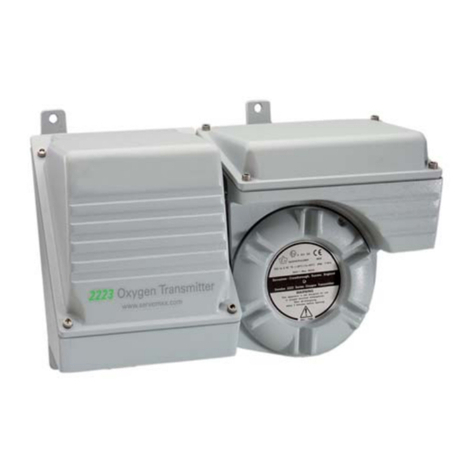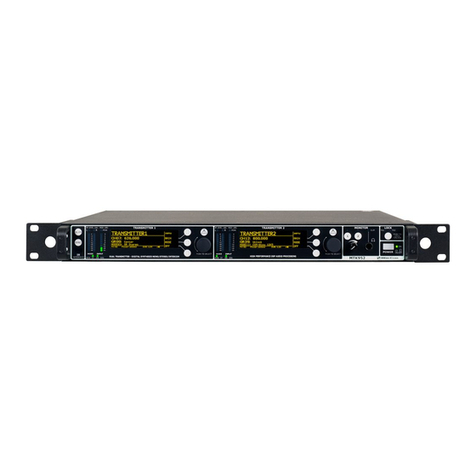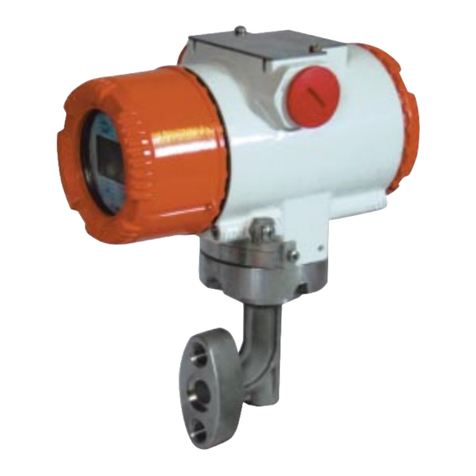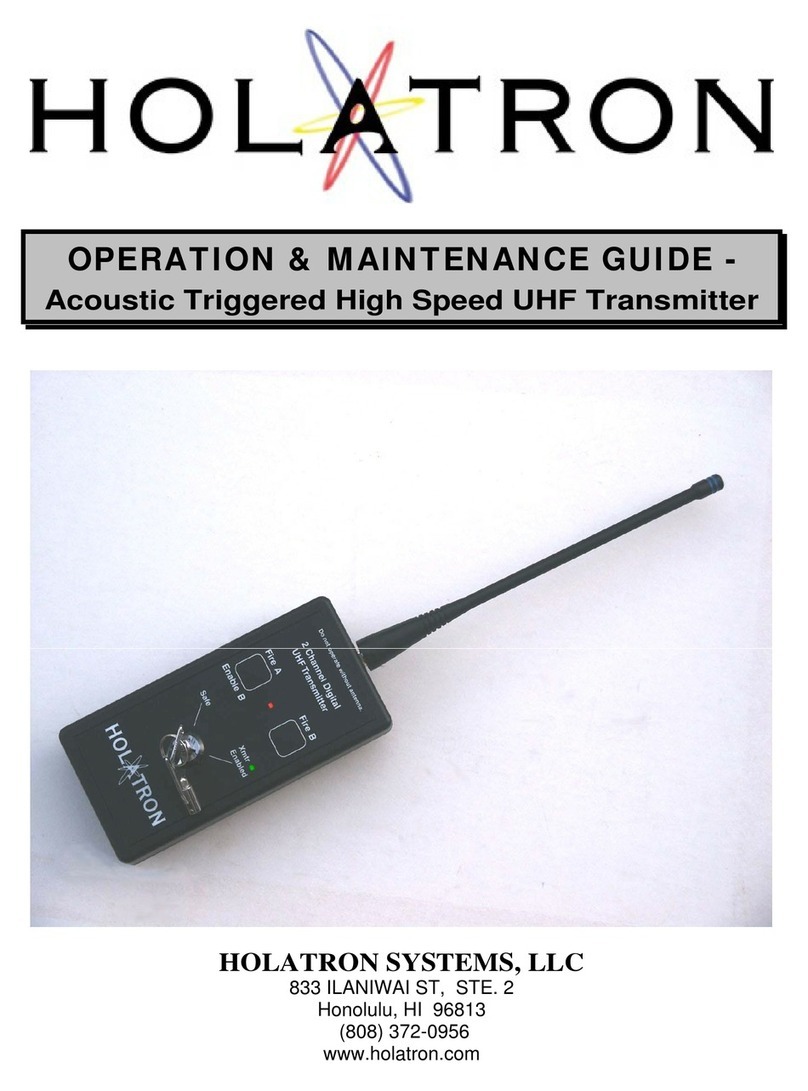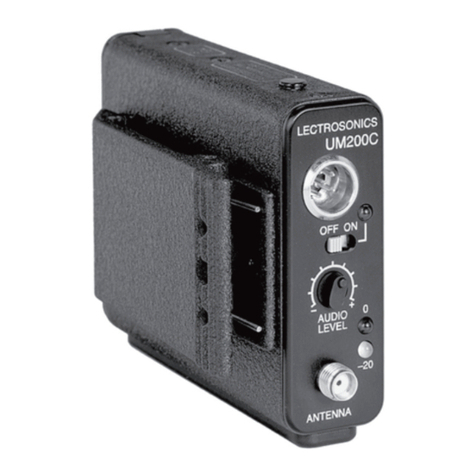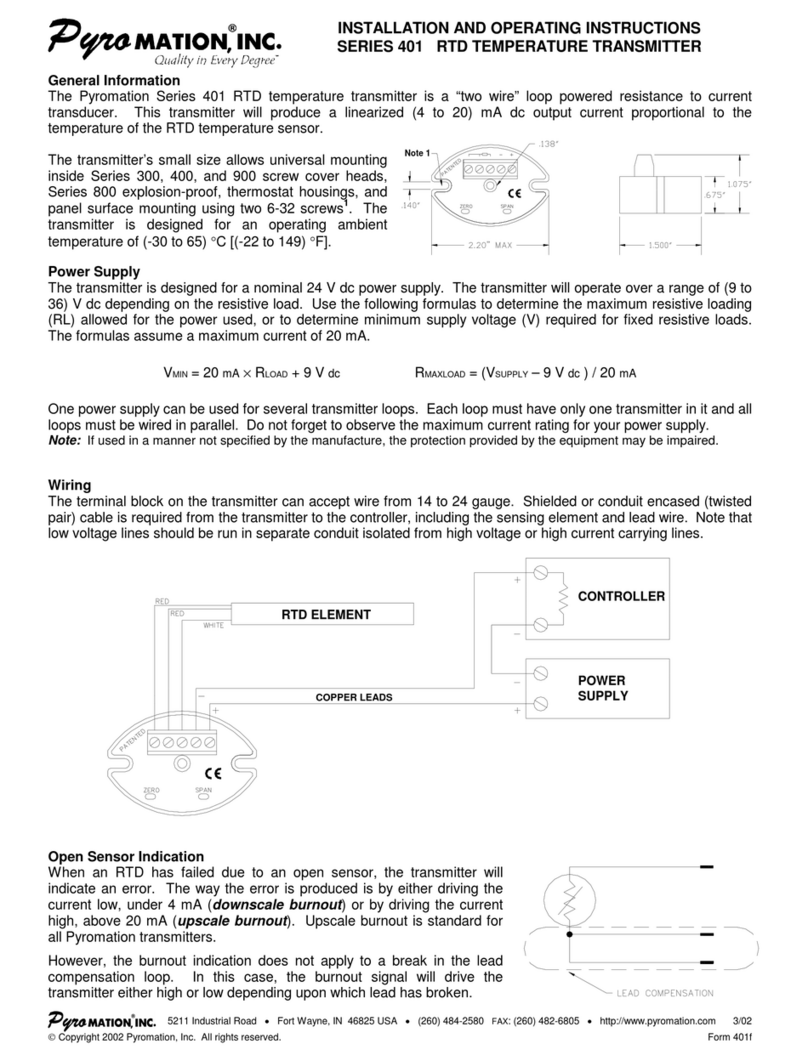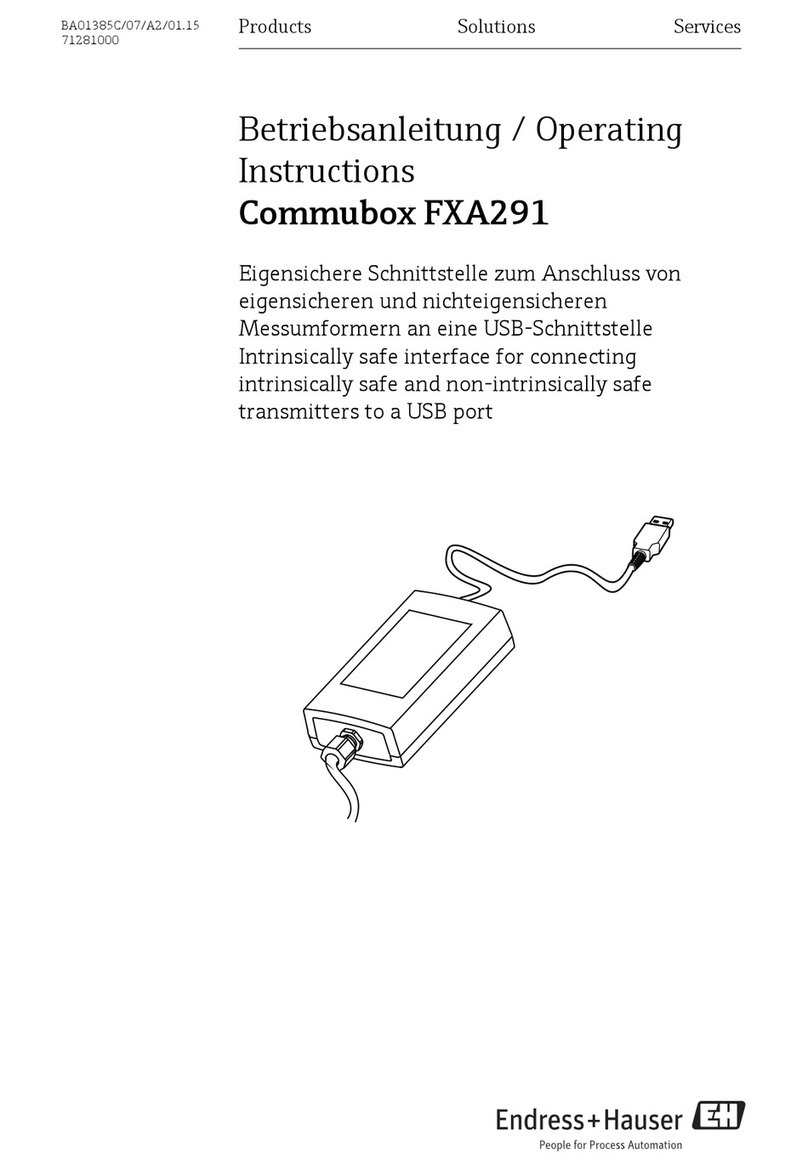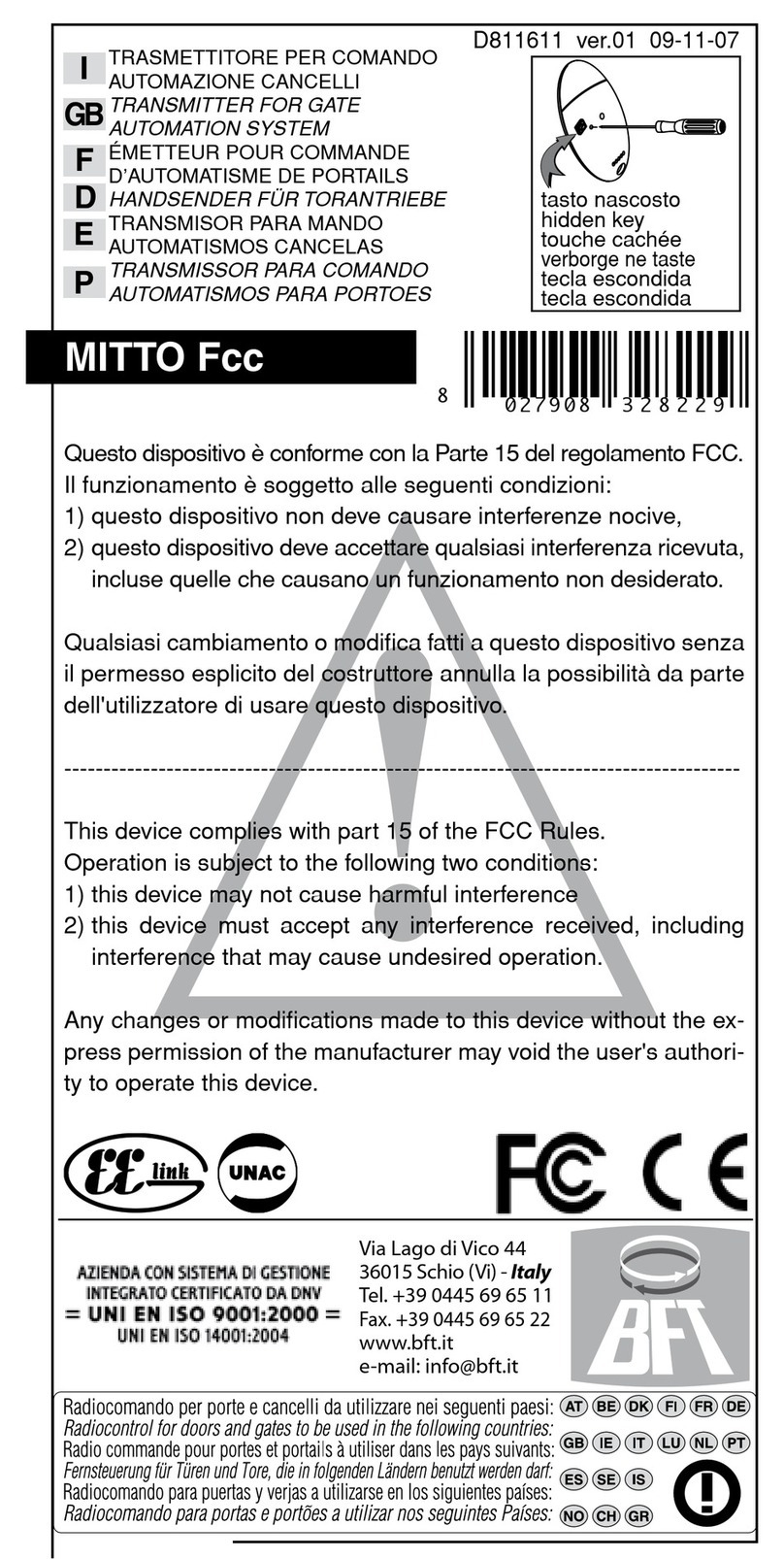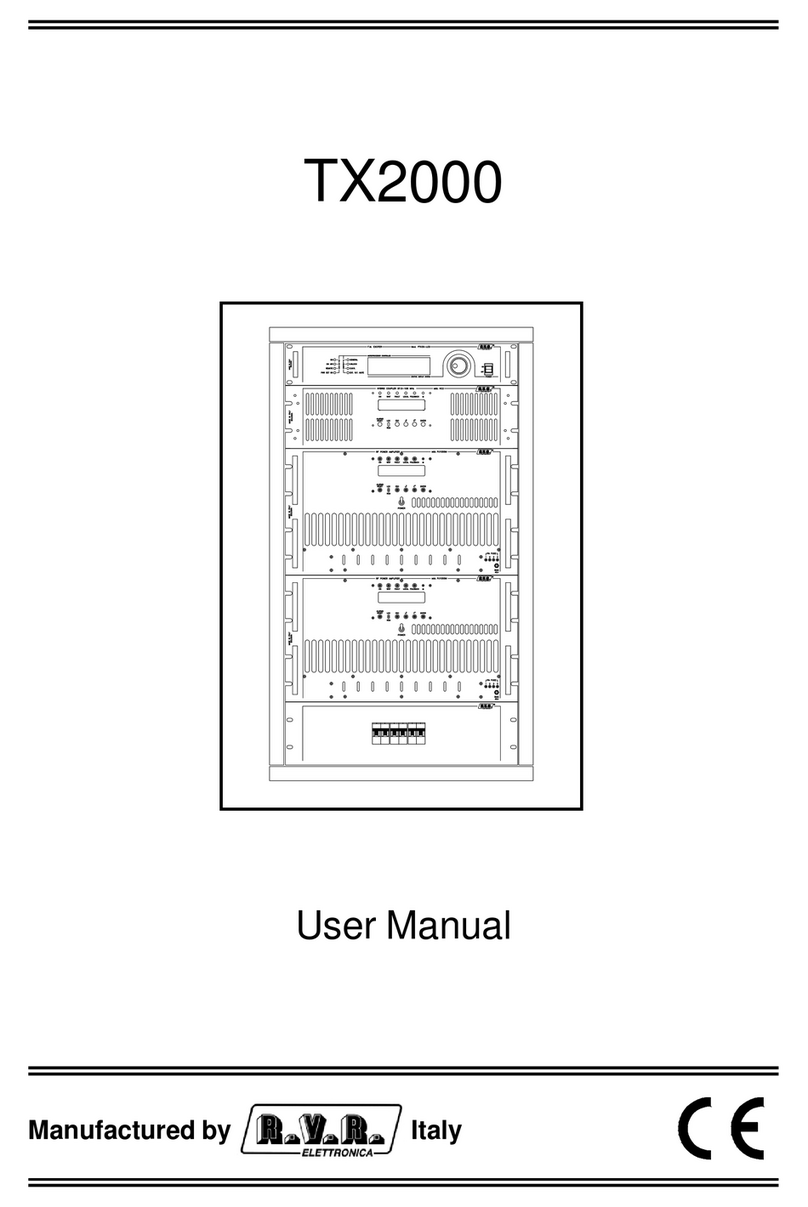Servomex AquaXact 1688 User manual

AquaXact 1688 Dew Point Transmitter
Operator Manual

2 © Servomex Group Limited 2017 AquaXact Issue 1.0
IMPORTANT INFORMATION
Continued safe and reliable operation of this equipment is conditional on all installation, operation and
maintenance procedures being carried out in accordance with the appropriate manuals, by personnel having
appropriate qualifications, experience and training. Failure to observe the requirements of the manual may result
in the user being held responsible for the consequences and may invalidate any warranty. Servomex accepts no
liability for unauthorised modifications to Servomex supplied equipment.
Servomex has paid particular attention to Health and Safety throughout this manual. Where special precautions
need to be taken due to the nature of the equipment or product, an appropriate safety icon and warning
message is shown. Special attention should be made to section 3 – Safety, where all such messages are
summarized.
This document, and all specifications and drawings within the document, are the property of Servomex, unless
agreed otherwise by contract, and are issued in strict confidence. They must not be reproduced, copied or
transmitted in any form, or by any means, or used as the basis for the manufacture or sale of apparatus,
programs or services without permission.
In line with our continuous policy of research and development, Servomex reserves the right to amend models
and specifications without prior notice, therefore the information in this document is subject to change without
notice and does not represent a commitment on the part of Servomex Group Limited. This handbook is accurate
at the date of printing, but will be superseded and should be disregarded if specifications or appearance are
changed. Check the internet for updates to the manual. The latest revision of this manual is available in Adobe
Acrobat format at www.servomex.com.
The customer agrees that in accepting and using this instrument Servomex’s liability arising from or in any way
connected with this instrument shall be limited exclusively to performing a new calibration or replacement or
repair of the instrument or sensor, at Servomex’s sole option, as covered by Servomex’s warranty. In no event
shall Servomex be liable for any incidental, consequential or special damages of any kind or nature whatsoever,
including but not limited to lost profits arising from or in any way connected with this instrument or items
hereunder, whether alleged to arise from breach of contract, express or implied warranty, or in tort, including
without limitation, negligence, failure to warn or strict liability.
Servomex is a registered trademark of Servomex Group Inc. The use of all trademarks in this document is
acknowledged.
North America:
Europe:
Representative:
Servomex Group Inc.
4 Constitution Way
Woburn MA 01801-1087
United States
Servomex Group Ltd
Jarvis Brook
Crowborough
East Sussex TN6 3FB
United Kingdom
t: +1 781 935 4600
+1 800 433 2552 (US toll free)
f: + 1 781 938 0531
e: americ[email protected]
w: www.servomex.com
t: + 44 (0) 1892 652 181
f: + 44 (0) 1892 662 253
e: europe_sales@servomex.com
w: www.servomex.com
© 2017. Servomex Group Limited. A Spectris Company. All rights reserved

AquaXact Issue 1.0 © Servomex Group Limited 2017 3
Contents
1Introduction ............................................................................................................................ 5
About this manual ........................................................................................................... 51.1
Product overview ............................................................................................................ 61.2
Product identification ....................................................................................................... 61.3
Ordering options ............................................................................................................. 61.4
2Unpacking............................................................................................................................... 7
3Safety ...................................................................................................................................... 8
Installation ....................................................................................................................... 83.1
Operation ........................................................................................................................ 93.2
Electromagnetic compatibility considerations .................................................................. 93.3
4Installation ............................................................................................................................ 10
Sensor installation ......................................................................................................... 104.1
Mechanical installation .................................................................................................. 134.2
Electrical installation...................................................................................................... 144.3
5Operation .............................................................................................................................. 16
Starting up .................................................................................................................... 16
5.1
6Technical specification ........................................................................................................ 17
Instrument ..................................................................................................................... 176.1
Sensor .......................................................................................................................... 186.2
Approvals / classifications ............................................................................................. 186.3
7Routine maintenance ........................................................................................................... 19
Preventative maintenance ............................................................................................. 197.1
8Troubleshooting ................................................................................................................... 20
Instrument ..................................................................................................................... 208.1
Sensor .......................................................................................................................... 218.2
9Storage and disposal ........................................................................................................... 23
Storage ......................................................................................................................... 239.1
Disposal ........................................................................................................................ 249.2
10 Spares ................................................................................................................................... 25
11 Warranty ............................................................................................................................... 26
Maintenance policy ....................................................................................................... 2711.1
Return Authorization Request ....................................................................................... 2711.2

4 © Servomex Group Limited 2017 AquaXact Issue 1.0
Appendix A Mechanical Drawings ......................................................................................... 29
A.1 Dew point transmitter .................................................................................................... 29
A.2 Sample block ................................................................................................................ 30
A.3 Sampling panel ............................................................................................................. 31
Appendix B Current vs. dew point ......................................................................................... 32
Appendix C Relationship of 4-20 mA output and instrument reading in ppmV or LBS ..... 34
Appendix D Uncertainty in LBS & ppmV calculations ......................................................... 35
Appendix E Sensor response time ........................................................................................ 36
E.1 AquaXact 1688 Calibration Options .............................................................................. 37
Index ............................................................................................................................................ 38

AquaXact Issue 1.0 © Servomex Group Limited 2017 5
1 Introduction
About this manual 1.1
1.1.1 Scope of the manual
This manual covers the installation, operation and routine maintenance of the AquaXact
1688 Dew Point Transmitter. It is intended for those already familiar with the installation,
use and maintenance of analytical or process instrumentation.
1.1.2 Safety information
Read this manual and make sure you fully understand its contents before you attempt to
install, use or maintain the device.
The following icons are used throughout this manual to identify any potential hazards that
could cause serious injury to people. Always follow the safety instructions and be aware of
the hazard.
This symbol warns of specific hazards which, if not taken into account,
may result in personal injury or death.
This symbol warns of specific hazards due to high voltages which, if not
taken into account, may result in personal injury or death.
This symbol warns of specific hazards due to high temperatures which, if
not taken into account, may result in personal injury or death.
This symbol warns of specific hazards due to hazardous substances
which, if not taken into account, may result in personal injury or death.
This symbol warns of specific hazards due to caustic or corrosive
substances which, if not taken into account, may result in personal injury
or death.
This symbol highlights where you must take special care to ensure the
equipment or property is not damaged.
1.1.3 Other information provided by the manual
Note:
Notes give extra information about the equipment.
Hint:
Hints give helpful tips and highlights information which is useful for you to be
aware of, for example, specific operating conditions.

6 © Servomex Group Limited 2017 AquaXact Issue 1.0
Product overview 1.2
The basic AquaXact 1688 dew point transmitter is a microprocessor based 4-20 mA loop-
powered hygrometer designed to measure moisture content in gases in a wide range from
-100 °C to +20 °C dew point in gases.
The measurement is transmitted by varying the current drawn (4-20 mA) from the power
supply, where the current varies in a proportional manner to the selected measurement
units.
In addition to the 4-20mA transmission a digital output can be used in conjunction with a
Servomex 1688 controller or MonoExact DF310E analyzer. Thus the AquaXact 1688 is
capable of communicating with properly equipped external computers or DCS systems as
well as the proprietary Servomex controllers. The AquaXact controller also allows field
span measurements and supports the field based sensor tip replacement process
(Appendix E). The AquaXact 1688’s advanced design allows it to be housed in a small
stainless steel enclosure behind the sensor probe making the transmitter and sensor a
single integrated unit.
The AquaXact 1688 uses the Servomex thin film Al2O3 technology sensor which is
encapsulated in sintered stainless steel making it compatible with a wide variety of
environments.
The sensor is a sensitive device and it should be handled accordingly.
Product identification 1.3
Figure 1-1: The AquaXact 1688 Dew Point Transmitter
Ordering options 1.4
For the latest ordering options please contact your local Servomex agent or visit
www.servomex.com.

AquaXact Issue 1.0 © Servomex Group Limited 2017 7
2 Unpacking
Read this manual carefully BEFORE you remove the AquaXact 1688 Dew
Point Transmitter from its box, or you attempt to install, commission or
use the equipment.
1. Examine the AquaXact package for damage or mishandling. If any damage is evident
notify the carrier and request an inspection.
2. Unpack the box. It should contain:
Transmitter and sensor in desiccant container. The transmitter should be stored in
the desiccant container when not in use.
Mating connector.
3. A USB memory stick with calibration files and an Adobe Acrobat file of this manual.
Check that you have received all of the items that you ordered. If any item is missing,
contact Servomex or your local Servomex agent immediately.
4. Inspect the items supplied, and check that they are not damaged. If any item is
damaged, contact Servomex or your local Servomex agent immediately.
5. Read section 3 – Safety before proceeding further.
Hint:
Keep the shipping documentation and packaging for future use, for example
when moving the equipment, or returning it for service or repair.

8 © Servomex Group Limited 2017 AquaXact Issue 1.0
3 Safety
The Servomex thin film Al2O3 sensor is designed and field proven to be highly reliable,
rugged and maintenance free. However the user should be aware of the following
precautions:
Installation 3.1
To avoid prolonged dry-down (when expecting to measure dew points
drier than -65 ºC), do not expose the sensor to room air longer than 1 - 2
minutes.
Do not open the desiccated sensor container before you are ready to
install the sensor.
The sensor container has desiccant to keep the sensor dry during
shipping and to avoid damage due to condensation. Close the container
using the attached red plug immediately after removing the sensor to
avoid degradation of the desiccant.
Do not throw away the sensor container. You may use it again to
transport the sensor between locations, to store it between uses or to
ship it back to the factory for certification. The container can be attached
to the loop cable, by trapping the cable with the lid strap.
Do not expose the sensor to corrosive gases or liquids such as ones
containing Chlorine, Ammonia or HCl. Cyanide, Br2, I2, NH3 and HNO3
may harm the gold layer of the sensor and limit the sensor life.
Do not expose the sensor to liquid water, as it may get damaged.
Do not breathe directly onto the sensor, as condensation may form
which could damage the sensor element.
Do not install the sensor near high heat sources such as radiators or air
ducts.
Do not install the sensor in places subject to extreme mechanical
vibration or shock.
Do not disassemble the porous metal filter encapsulation. This will
damage the sensor and void your factory warranty.
Before you install the probe, make sure that no contaminants are present
in the system (e.g. oil, liquid water).

AquaXact Issue 1.0 © Servomex Group Limited 2017 9
Operation 3.2
The AquaXact 1688 uses state-of-the-art microelectronics to provide a miniature full
functioning transmitter. The user should consider the following precautions when using any
sensitive electronic device:
Do not install the unit near heat sources such as radiators or air ducts.
Do not install the unit in places subject to extreme mechanical vibration
or shock.
Observe the appropriate electrical safety codes and regulations.
Electromagnetic compatibility considerations 3.3
The AquaXact 1688 has been designed and verified by testing to meet the requirements of
the EU EMC Directive 2014/30/EU, for Industrial, Scientific & Medical equipment. The
sensor and the 4-20 mA loop are electrically connected, however they are isolated from
the AquaXact 1688 housing and sample cell fitting threads. Please consider the following
electromagnetic interference issues during installation:
In order to provide an acceptable noise environment for the AquaXact 1688 or any
other digital equipment in the proximity of switching inductive loads, it is recommended
that there be varistors placed across the inductors to keep down the high voltage spikes
during transitions.
AC power wiring should be routed as far away from the AquaXact 1688 and its wiring
as practical.

10 © Servomex Group Limited 2017 AquaXact Issue 1.0
4 Installation
Do not attempt to install, commission, maintain or use the AquaXact
1688 Dew Point Transmitter unless you are trained and know what you
are doing.
Follow the instructions in this section to safely install the AquaXact 1688
Dew Point Transmitter.
Do not install the unit in places subject to extreme mechanical vibration
or shock. If you do, sample measurements may not be accurate and the
transmitter may be damaged.
Sensor installation 4.1
The moisture content at the sensor is not only due to the moisture of the gas being
measured, but is also due to desorption of water from tubing, trapped moisture (at the
interconnection points, valves, filters and other hygroscopic materials in the system), leaks
in the system and others. As a result the measurement may vary from what is expected
and care should be taken in choosing the sampling approach utilized in the measurement.
Factors such as gas pressure, flow rate, materials of construction, length and diameter of
tubing, number of interconnecting fittings, dead space in tubing and manifolds will
influence the observed measurement value and response time.
The high-capacitance thin-film sensor can be installed either directly in the line to be
sampled (in-situ), or in a slip stream of a sample system (extractive). To assure a long and
accurate performance of the sensor, it should be protected from contaminants such as
liquids (water, oil etc.), and particulates. The sintered stainless steel sensor encapsulation
protects from particulates larger than 100 microns, finer particulates (e.g. from degraded
desiccant or rust) should be filtered with a particulate filter with suitable capability, do not
use hygroscopic filter materials.
4.1.1 In-situ installation
In-situ installation is recommended only for measurements where the gas pressure is
expected to be constant, the gas is expected to be free of contaminants, the gas
temperature is within the operating specifications of the sensor and there is no chance of
liquids coalescing. Examples of applications suited for in-situ installations are pure gases
or output of desiccant dryers (for instrument air), glove boxes, etc. For most other
applications in-situ installation should be avoided for the following reasons:
Sample conditioning is almost always necessary to avoid exposure of the sensor to
liquid water and other contaminants, such as hydrocarbons, which may damage the
sensor or affect accuracy over time.
If the gas line is under pressure, it is more likely that water condensation occurs which
may damage the sensor.

AquaXact Issue 1.0 © Servomex Group Limited 2017 11
Under a pressurized system removal of the sensor without the installation of isolation
valves can be dangerous. If in-situ installation is required, bypass mounting is
preferable. If in-line installation is required, make sure to install the sensor at the upper
surface of the gas line to minimize its exposure to liquid water should condensation
occur. Also consider the need to isolate (depressurize) before installing or removing the
sensor.
Variations in line pressure affect the reading of the sensor because dew point varies
with pressure.
Figure 4-1: In-situ installation

12 © Servomex Group Limited 2017 AquaXact Issue 1.0
4.1.2 Extractive installation
For extractive installations we recommend our sample handling systems, which may be
equipped with a variety of features, such as isolation valve, particulate filter, pressure
regulator, calibration sample injection or extraction port, pressure gauge, flow meter.
Contact your local Servomex sales office for more information on sampling system options
It is generally recommended to measure at ambient pressure for the following reasons:
The readings will not be affected by variations in line pressure.
The risk of exposing the sensor to liquid water is significantly reduced.
If the resources to make your own sample system are available Figure 4-2 can be used as
a guideline to configure a sampling system.
Figure 4-2: Extractive installation
The transmitter is programmed to send ppm readings (if that engineering unit is specified
via purchase order or set through the digital controller) that are computed for a pressure of
one atmosphere (1 bar); and have to be corrected using a pressure compensation
calculation if the sensor is measuring at different pressures. The programmed process
pressure can adjusted using the digital controller if equipped.
Make sure that:
The sample is taken from the upper surface of the main gas line. This avoids problems
with contamination. The sample should be taken away from pipe line walls where flow
rates may be low, and dew point changes may lag.
For dew points dryer than -40 °C , use stainless steel tubing only. Copper tubing is
acceptable for dew points wetter than -40 °C. Never use plastic, rubber tubing under

AquaXact Issue 1.0 © Servomex Group Limited 2017 13
any circumstances, as measurements would be incorrect and/or response time slow
due to water retention inside these materials.
Try to run pipes to the sensor upwards, so that contaminants tend to fall back into the
main line.
Keep the length of the sample line to the sensor as short as possible.
Use small diameter pipes (1/4” or 1/8” OD).
Use sufficient flow rates (e.g. 2-15 liter/min with 6 feet of 1/8” piping is recommended).
The flow rate will influence the systems response time.
Do not install any devices upstream of the sensor, such as other measuring systems,
flow meters etc., which are not absolutely necessary as these are potential leak
sources.
Install a coalescing and / or particulate filter ahead of the sensor to prevent any liquid or
particulate contamination of the sensor.
If filters are used upstream of the sensor, make sure these only contain non-
hygroscopic filter materials.
If pressure regulators, shut-off valves etc. are used upstream of the sensor, make sure
they do not contain rubber or other hygroscopic materials.
Mechanical installation 4.2
Various adapters are available for direct connection into existing dew point transmitter
openings. Ask your representative for a sample block cell, if you do not have the ability to
provide an appropriate sample cavity mounting. If the 14 mm x 1.25 mm thread is used
then the AquaXact will seal against the wall of the sample cell with the provided Viton A
O-ring. The AquaXact is light enough such that the standard thread will mechanically
support the whole transmitter. To prevent any leaks, tighten the transmitter into the sample
cavity, with a 1½ “wrench, 1/8 turn past finger-tight to assure metal-to-metal contact, do
not exceed 15 foot-pounds.
The sensor tip can be removed from the transmitter by unscrewing it (Figure 4-3). Make
sure that the sensor is securely fastened to the transmitter (the tension washer should be
compressed), so that it does not come loose during use, do not over-tighten because the
sintered material will break.

14 © Servomex Group Limited 2017 AquaXact Issue 1.0
Figure 4-3: Mechanical installation – remove sensor tip
Electrical installation 4.3
The AquaXact 1688 will operate properly with 13 Vdc minimum to 33 Vdc maximum at its
input, if this voltage is exceeded the internal fuse may open, this fuse will self-reset after a
cool down time. When selecting the power supply voltage do not neglect the voltage drop
across any current measurement resistor and wiring in the loop. The keyed connector is
an industrial standard 9.4 mm, 7-pin connector, IP65 NEMA 4X (Figure 4-4). Do not force
the connector. When the connector engages, secure it with the retention screw.
The AquaXact 1688 will draw 4 mA to 20 mA from the power supply depending on the dew
point being measured. The dew points corresponding to 4 mA and 20 mA are the
full -100 °C to 20 °C range. The range is user selectable via the Servomex digital
controller. In between 4 mA and 20 mA, the current varies linearly with dew point. There
are two custom ppm ranges that can be ordered namely 0-100 ppm and 0-1,000 ppm.
Please observe good electrical safety and grounding practices when connecting any
electrical equipment; connecting one end (e.g. negative) of the power supply to earth
ground is advisable.

AquaXact Issue 1.0 © Servomex Group Limited 2017 15
Figure 4-4: Electrical installation – connector and connections

16 © Servomex Group Limited 2017 AquaXact Issue 1.0
5 Operation
Starting up 5.1
It is advisable to carry out an initial purge of the sample loop before installing the
transmitter in order to eliminate the possibility of damage on startup.
Before the transmitter is installed into the sample block open the inlet isolation valve slowly
until a small flow of process gas flows though the transmitter block and exhausts through
the transmitter block outlet transmitter opening.
Allow the purge to continue for about 20 minutes to remove residual moisture from the
sampling pipework. Close the inlet isolation valve and install the transmitter into the
sampling block. Connect the cable and secure it using the retaining ring.
Note: The plugs and sockets only locate in one position because the pins are of different
sizes in the tip, and the main connector is keyed.
Open the inlet slowly and allow a low pressure purge through the whole system. Set the
required pressure flow within the sample loop.
The instrument is ready for use as soon as the power cable is installed. When power is
applied the instrument will initialize its program.
Once completed and powered, the device is on line but gas sample lines could take
several hours to clean up and reach equilibrium.

AquaXact Issue 1.0 © Servomex Group Limited 2017 17
6 Technical specification
The protection, accuracy, operation and condition of the equipment may
be impaired if the device is not installed in accordance with the
requirements of this and other sections of the manual.
Instrument 6.1
Dimensions:
Includes sensor and connector
Diameter x length
31.5 x 136 mm
1.24 x 5.36 inches
Mass:
175 grams
Enclosure:
Stainless steel
Operating temperature:
-22 to +158 °F (-30 to +70 °C)
Mechanical connections:
5/8”-18 threads.
Adapters for other threads are available.
Electrical connections:
Industrial Standard 9.4mm 7-pin connector IP65
Cable:
The digital seven conductor cable or the two
conductor 4-20mA cable must be shielded to meet
CE requirements; for ambient temperatures above
60 °C make sure that wiring temperature rating
exceeds the maximum expected ambient
temperature.
Maximum digital cable length:
200 metres.
Power requirements:
13 Vdc (min) to 33 Vdc (max), the instrument draws
4 - 20mA depending on measured dew point
Input resolution:
0.1 ºC dew point
Engineering units:
Factory programmed:
°C dew point
°F dew point
ppmV
Controls:
Digital RS485 with AquaXact Controller
Outputs:
Analog and digital outputs are available:
4-20 mA drawn by the instrument from the

18 © Servomex Group Limited 2017 AquaXact Issue 1.0
power supply. The 4-20 mA is linear to the
engineering units, the range is programmable.
Output resolution is 0.1 °C dew point or
~0.25 µA whichever is greater.
In the digital mode the AquaXact 1688 can be
remotely operated, the dew point & temperature
can be read.
Alarms:
The 4-20 mA signal or the digital output may be
used by an external device to operate relays.
Isolation:
The sensor is connected to the current loop but,
isolated from the AquaXact 1688 housing and
installation
Sensor 6.2
Type:
Thin film high capacitance Al2O3
Dew point range:
-100 °C to +20 °C
Accuracy:
± 3 °C
Repeatability:
± 0.5 °C
Typical Response time:
See the graph in Appendix E
Temperature range:
-10 °C to +70 °C
Sample pressure range:
0 to 100 psig
Sample flow range:
2 to 15 l/min
Storage temperature:
-40 °C to +80 °C
Mechanical:
Encapsulated in 100µ sintered stainless steel
Calibration method:
NIST/NPL traceable multi-point factory calibration
Approvals / classifications 6.3
CE:
CE for electromagnetic compatibility, accredited laboratory tested and certified.

AquaXact Issue 1.0 © Servomex Group Limited 2017 19
7 Routine maintenance
The AquaXact 1688 Dew Point Transmitter does not contain any user
serviceable parts.
Do not attempt to maintain or service the AquaXact 1688 Dew Point
Transmitter unless you are trained and know what you are doing. The
transmitter must be maintained by a factory-trained field service
engineer.
Sample and calibration gases may be toxic or asphyxiant.
Never inspect the inlet filter(s), or service or repair the transmitter while
such gases are still connected to it.
If the transmitter is to be serviced or repaired it is important that all
pipework is flushed with an inert gas and the transmitter is allowed to
freely vent to local atmosphere.
Do not store replacement tips for more than 12 months before use to
assure the calibration is still valid.
Preventative maintenance 7.1
To minimize unscheduled instrument downtime, ensure the proper operation of the
AquaXact and to comply with the guidelines of applicable regulatory bodies, we
recommend that you utilize an annual preventative maintenance program for your
transmitter.
The preventative maintenance program consists of an annual inspection of the AquaXact,
and repair of any faults. To ensure that the AquaXact meets its original factory
specification we recommend that the sensor tip be replaced every year. This can be
accomplished by the user if equipped with a digital controller.
Contact Servomex or your local Servomex agent to arrange for a preventative
maintenance contract.

20 © Servomex Group Limited 2017 AquaXact Issue 1.0
8 Troubleshooting
Instrument 8.1
This instrument performs diagnostic tests on power up as well as once every three
seconds. The following table lists possible error/unexpected indications that may occur.
Symptom
(more than 25 seconds after power up)
Possible cause
Remedy
Current loop
Pin 3
Fixed at 21 mA
1. Failed Device
2. Open sensor
3. Shorted sensor
Check sensor & cycle
power, if problem
persists return
instrument
4 to 20 mA
Normal operation
0 mA
High impedance
1. Cable open
2. Fuse open due to
excessive voltage
1. Check cables
2. Check power 13 to
33 Vdc
Check source
polarity pin 7 +;
Pin 1 –
3. Cycle power
Table of contents
Other Servomex Transmitter manuals
Popular Transmitter manuals by other brands
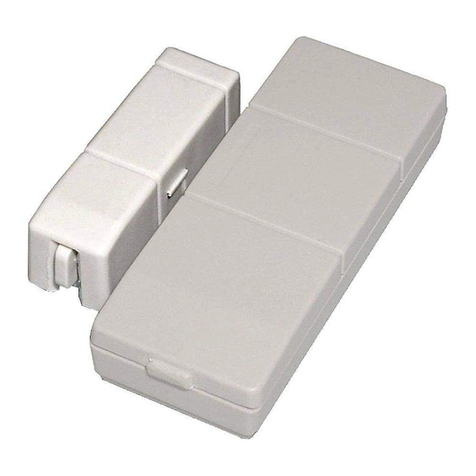
Linear
Linear DXS-31 installation instructions
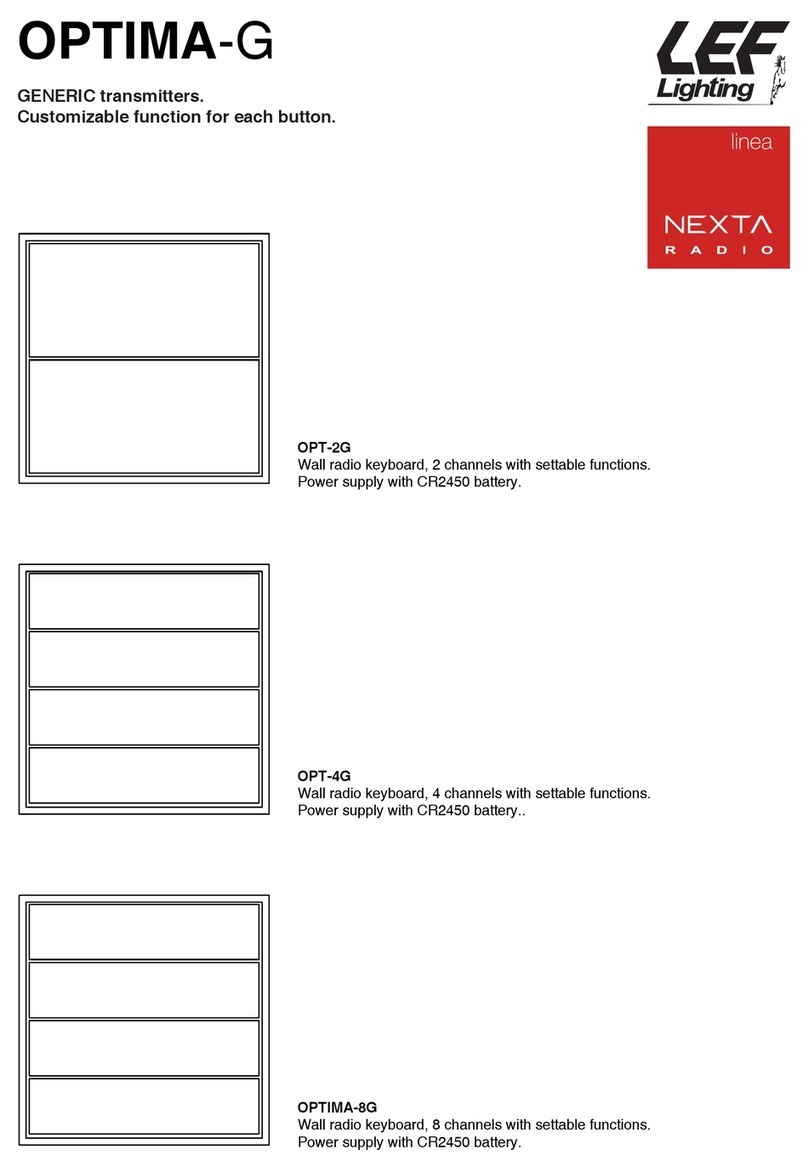
LEF LIGHTING
LEF LIGHTING OPTIMA-G quick start guide
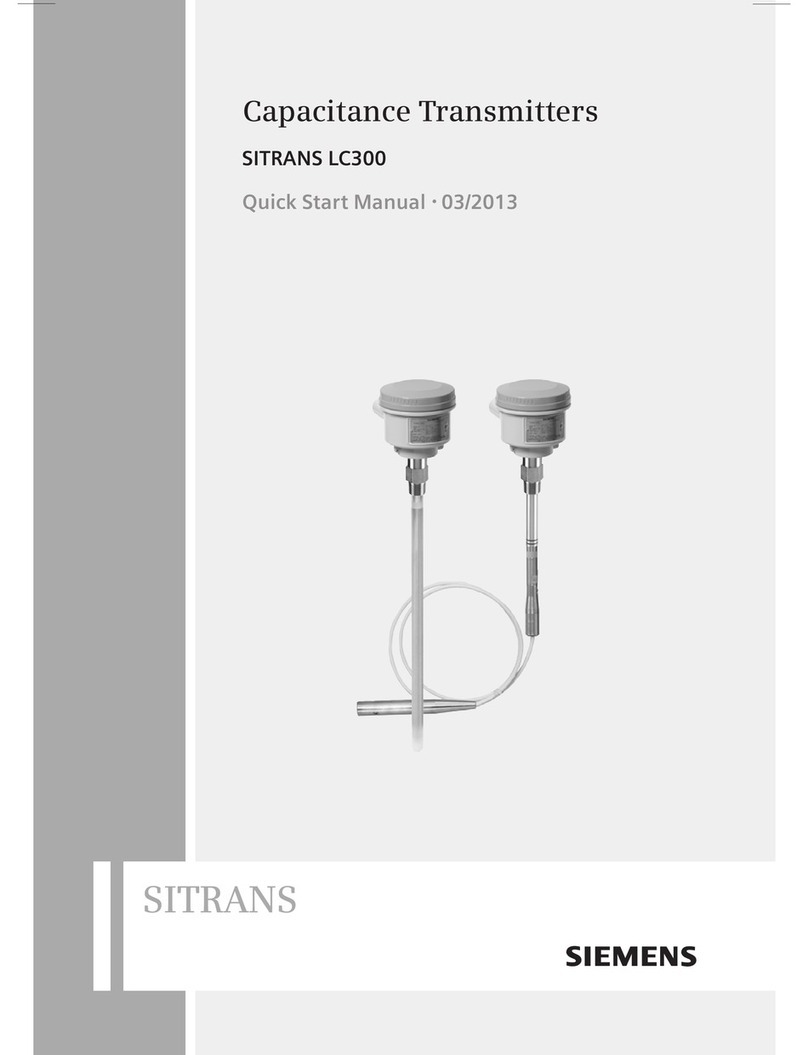
Siemens
Siemens sitrans lc 300 Quick start manual
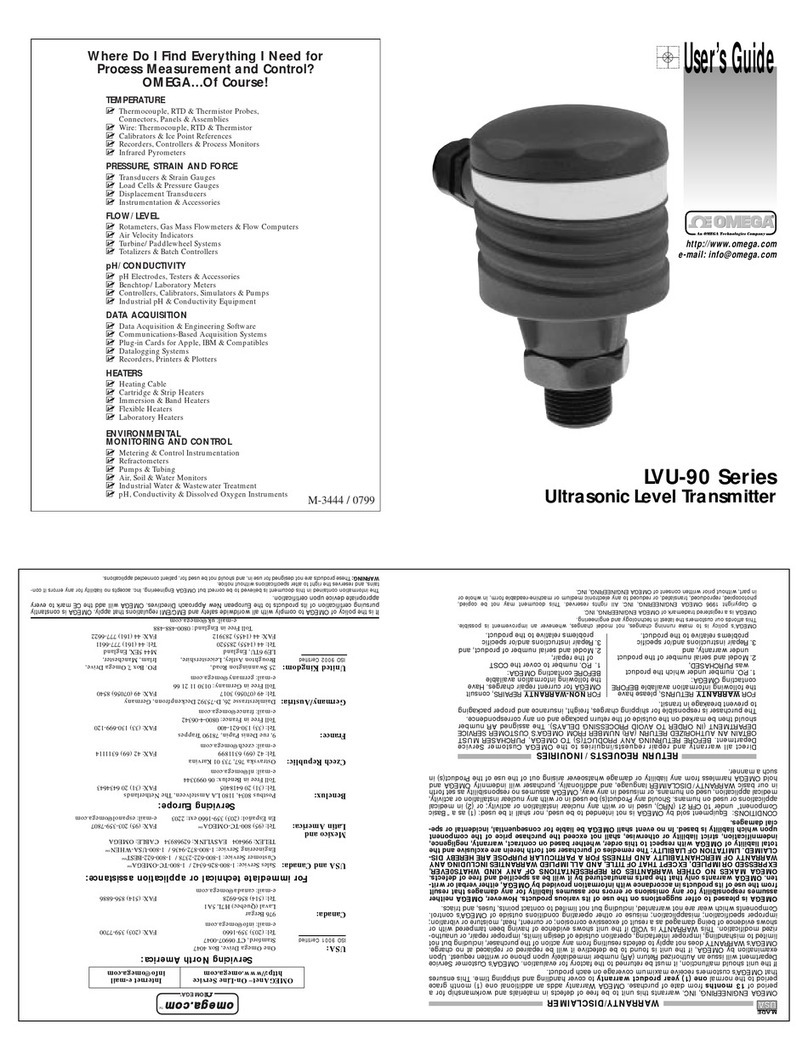
Omega Engineering
Omega Engineering ULTRASONIC LEVEL TRANSMITTER LVU-90 user guide
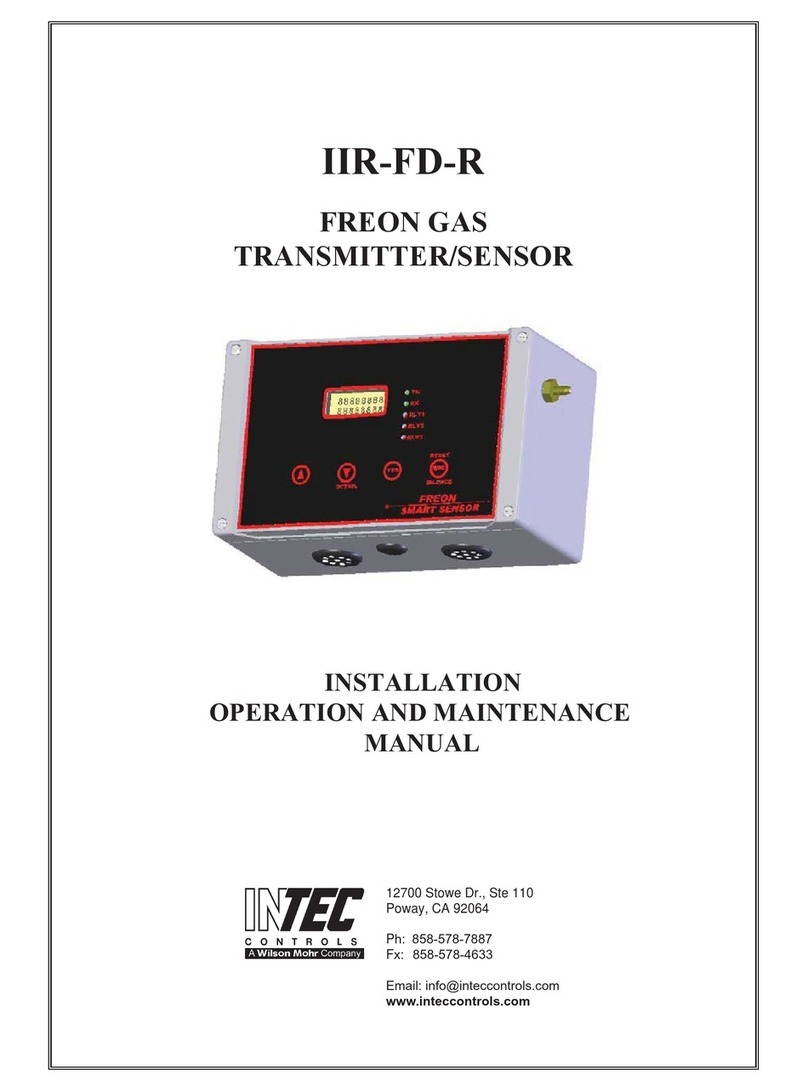
Intec Controls
Intec Controls IIR-FD-R Installation, operation and maintenance manual

Rinstrum
Rinstrum 1203 Reference manual
